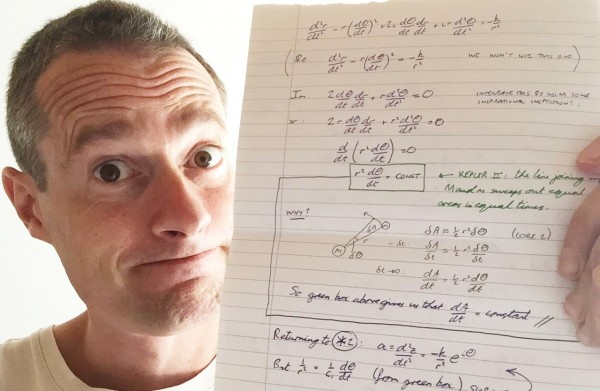Isaac Newton is famous for inventing gravity. Before Newton, we were all just floating around, and you had to tie things to the floor of they’d drift away into space.
Only kidding, Newton did not in fact invent gravity. Neither to discover it, but he was the first person to write down the mathematical law to describe how gravity works. It’s called Newton’s universal Law of Gravitation (must have taken him ages to come up with that title).
When I was a schoolboy, Newton’s picture was on the back of the £1 note (the £1 coin only appeared in 1983). £1 was a lot of money back then, so if you had a “Newton” in your pocket you could buy the Beano comic, and the Dandy comic, and still have enough money left over for sweets. Here’s a photo of Isaac Newton on a £1 note (which annoyingly cost me £3 on ebay).

How much do you weigh? If your Dad says he weighs 95kg (“kilograms”) then he’s actually just given you his mass, not his weight. Weight is an example of a force (a push or a pull), so it’s measured in something called, you’ve guessed it, the NEWTON!! Each kilogram weighs about 10 Newtons on Earth, but only 1.6 Newtons on the moon – because the moon’s gravity is weaker than Earth’s. If your Dad wants to lose weight, he could move to the moon; his mass would stay the same, but his weight would drop by about 85%.
Isaac Newton’s tomb is in Westminster Abbey, where he is buried alongside Elizabeth I, Edward the Confessor, and many other Kings and Queens of England. Prince William and Katherine Middleton would have walked right past his tomb when they emerged from their Wedding in 2011, which could explain why they are so attracted to each other.
Attracted? Gravity? Oh, never mind…
Newton’s Law of Gravitation is very difficult to write down in words, but using the amazing language of algebra, it becomes very easy to write down:
F=-GMm/r2
Here’s what all the bits mean (you can skip this section if you like):
Isaac Newton was also a famous physicist, engineer and “polymath” (or “know-it-all” in today’s language). One of his greatest achievements was inventing CALCULUS: a branch of maths that uses lots of impressive squiggly notation like ∑ and ∫. Unfortunately for Newton, someone else called Liebniz invented calculus at the same time. Newton’s and Liebniz’s friends argued for years over who invented calculus first, which is a great shame because Newton and Liebniz were actually quite grown-up about it and hardly called each other any rude names at all.
Using calculus, Newton was finally able to explain that the Earth orbits the sun not in a circlular shape like everyone thought, but in an ellipse (a sort of squashed circle). Here is a photo of me using some very difficult maths to prove that Newton was right: we really do orbit the sun in an ellipse!
What kind of maths workshop or maths show would Newton do if he were alive today and came to visit your school? Probably a really hard one that few of us would be able to follow. But because he invented calculus and inspired me to be a better mathematician, Isaac Newton is one of my: SUPERSTARS OF MATHS!!!
Comments welcome, please visit the House Of Maths Facebook Page
[mc4wp_form id=”399″]